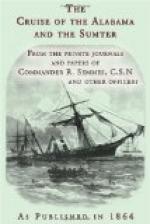The next day, Saturday, August 30th, saw the preparations for the battery complete, and the pivot guns finally mounted, and ready for action. The men were now allotted to the various stations, and mustered at quarters, when it was found, that by telling off half a dozen of the junior officers to complete the crew of the rifled gun, there were just hands enough to fight the ship. This was satisfactory; and altogether the five hard days’ work since quitting Terceira had resulted in something more like success in the way of order, comfort, and efficiency, than it had at first sight appeared possible to anticipate.
Sunday, August 31st, was a welcome day of rest to all on board; the only break being a brief run off after a brig to leeward, which on being challenged with French colours, proved to be a Portuguese. During the day the Alabama made good running to the westward, under topsails, with a fresh breeze well on her starboard quarter; and at midnight made all snug, and brought by the wind on the port tack. The next day was passed for the most part in quietly lying to under topsails, with her head to the southward and eastward, whilst the crew were employed in finishing the fittings of the battery, and scraping the deck and bulwarks clear of some of the accumulated dirt, till 3 P.M., when she filled away again, and started upon a N.W. course.
By Tuesday, Sept. 5th, the Alabama had run into the thirty-eighth parallel, and the temperature was sensibly altering. Up to this period no prize had been captured, the few vessels overhauled having all been under a neutral flag. On this day, however, whilst in chase of a brig, whose extraordinary swiftness enabled her fairly to show the Alabama a clean pair of heels, a vessel was descried in the offing, and the Confederate bore up and made towards her. On approaching she was found to be lying-to, with her foretopsail laid to the mast, and on a somewhat nearer inspection, proved evidently to be a whaler.




